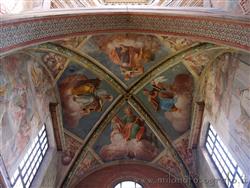|
Abbey of Chiaravalle
|
|
|
Show an other treasure of art and history in Milan:
|
 Mostly represented styles: Gothic - Renaissance Mostly represented styles: Gothic - Renaissance
The Abbey of Chiaravalle (in Latin Sanctae Mariae Clarævallis Mediolanensis, also known as Santa Maria di Roveniano) is a Cistercian monastery complex located immediately south of the main city complex of Milan. It was founded in the twelfth century by St. Bernard of Clairvaux as a subsidiary of the Abbey of Citeaux and an agricultural village developed around it. The entire complex was annexed to the municipality of Milan in 1923.
The church is one of the earliest examples of Gothic architecture in Italy, and is built entirely of red brick.
The first church was built starting from 1135, but the current one is in fact a construction which started only between 1150 and 1160. It was gradually enriched with various elements: during the XIII century the first Cloister was built, located south of the church. Later, in the fourteenth century, the lantern was built, the refectory and a chapel now used as a vestry. In 1490, Bramante and Giovanni Antonio Amadeo commissioned by Cardinal Ascanio Maria Sforza Visconti, began the construction of the Great Cloister and of the Chapter: in the Renaissance period many painters and artists worked at the abbey; of this period are the works of Bernardino Luini. Later, from 1613 to 1616, the so called Fiammenghi were commissioned to decorate the interior walls of church, which were literally covered with the beautiful frescoes visible even today.
With the transition to the nineteenth century, the complex began instead to lose pieces: under the Cisalpine Republic many parts of the monastery were demolished and only the church, a small part of the cloister, the refectory and the buildings entrance remained intact.
In 1861, to make way for the railway line Milan - Pavia and Genoa, the great cloister of Bramante was unfortunately destroyed.
Fortunately, what's left is still more than enough to make the Abbey of Clairvaux a wonderful monument, in particular the frescoes in the rear of the church, the cloister and the great tower. Worthy of note is also the fine walnut choir.
If you are interested in a guided tour of this monument send an email!
Categories: Churches / Religious buildings
Via Sant'Arialdo, 102 Chiaravalle Milanese,
20139 Milano |
Further pictures of the Abbey of Chiaravalle in the section Photography |